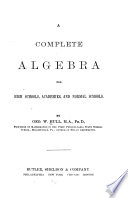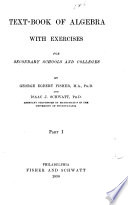 | George P. Lilley - Algebra - 1894 - 522 pages
...х - 25 z10 + 2 а? + 7 z6 - 8 х4 - 3 х8 - 15 ж8 + 10 хг - 5 а; -25 Explanation. Multiplying each term of the multiplicand by each term of the multiplier and connecting these results with their proper signs, we have x10 — x9 + 2 xe — x6 — 5 x* + 3 z9... | |
 | George Washington Hull - Algebra - 1895 - 358 pages
...2a2 + ab - 662, Ans. have 2aJ + 06 - 66Z. From this example we derive the following RULE. Multiply each term of the multiplicand by each term of the multiplier, and add the partial products. m2 + 2mn + w2, ^4ns. m2 — 2mn + n2 m'1 5. 6. a4 + rt'6 + a262 x*-x« + z4 -... | |
 | Fletcher Durell, Edward Rutledge Robbins - Algebra - 1897 - 482 pages
...Multiplication of Polynomials. The terms of each polynomial having been arranged, we proceed to multiply each term of the multiplicand by each term of the multiplier, and take the sum of the results. The reason for this is made clear by taking two polynomials, a + b and... | |
 | George Egbert Fisher, Isaac Joachim Schwatt - Algebra - 1898 - 712 pages
...article is derived the following principle for multiplying a multinomial by a multinomial: Multiply each term of the multiplicand by each term of the multiplier, and add algebraically the resulting products. Ex. l. Multiply -3a + 2& by 2a-36. We have -36x26 (1) = - 6 a2... | |
 | George Albert Wentworth - 1898 - 424 pages
...bm + bn + bp + cm + cn + cp. 102. To Find the Product of Two Polynomials, therefore, Multiply every term of the multiplicand by each term of the multiplier, and add the partial products. In multiplying polynomials, it is a convenient arrangement to write the multiplier... | |
 | William J. Milne - Algebra - 1899 - 172 pages
...times a + 6 = a'2 + a6 6 times a + b = ab + Ift (a + 6) times (a + 6) = a2 + 2 ab + 6" RULE. Multiply each term of the multiplicand by each term of the multiplier, and add the partial products. 2. 3. 2 ab - 3 ca? x — y ;26'2- lOa6c-Sc2 & Multiply : 4. x + ybyx + y. 17.... | |
 | Seymour Eaton - 1899 - 362 pages
...No. 9. Algebraic Multiplication (Continued) To multiply one compound expression by another, multiply each term of the multiplicand by each term of the multiplier, and add results for the complete answer. To find the product of a + b and c + d. (o+6) x(c + d) = (a + 6) (c+d)... | |
 | James Morford Taylor - Algebra - 1900 - 504 pages
...2\3ab-4:a(c-2b')l. 23. 7ac-2{2c(a-3&)-3(5c-2Z»)a|. 79. To multiply one polynomial by another, Multiply each term of the multiplicand by each term of the multiplier, and add the resulting products. Proof. Let x + y + z be the multiplicand, and a + b the multiplier ; then by... | |
 | George Edward Atwood - 1900 - 276 pages
...polynomial. RULE. — Arrange the multiplicand and multiplier with reference to the same letter. Multiply each term of the multiplicand by each term of the multiplier, and add the partial products. EXAMPLES. 2- 3a263+ 2o64 +26* b3 — 6a464+ - 8a464+ a —b +2 c +x -3 ac —... | |
 | George Egbert Fisher, Isaac Joachim Schwatt - Algebra - 1900 - 202 pages
...This example illustrates the following method of multiplying a multinomial by a multinomial : Multiply each term of the multiplicand by each term of the multiplier, and add algebraically the resulting products. In general, (a + 6)(c + d- e) = a(c + d- e) + b(c + d- e) = ac... | |
| |